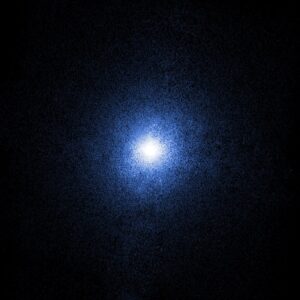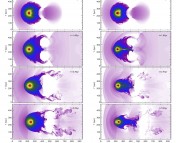Title: Radiative Particle-in-Cell Simulations of Turbulent Comptonization in Magnetized Black-Hole Coronae
Authors: Daniel Grošelj, Hayk Hakobyan, Andrei M. Beloborodov, Lorenzo Sironi, Alexander Philippov
First Author’s Institution: Centre for mathematical Plasma Astrophysics, Department of Mathematics, KU Leuven, B-3001 Leuven, Belgium & Department of Astronomy and Columbia Astrophysics Laboratory, Columbia University, New York, NY 10027, USA
Status: Accepted for publication in Physical Review Letters [closed access]
This bite was written and published as part of Astrobites’s new partnership with the American Physical Society (APS). As part of this partnership, we cover selected articles from the Physical Review Journals, APS’s premier publications covering all aspects of physics. For more coverage as part of this partnership, see our other PRJ posts.
X-rays in Black Hole Coronae
Cygnus X-1 (Cyg X-1) is an x-ray source within our own galaxy. It is a black hole with a mass about twenty-one times that of our sun and is part of a binary system along with a blue supergiant star. In such a system, material from the stellar component accretes, or transfers, onto the black hole component. This forms an accretion disk around the black hole and a corona of hot plasma. The corona is a major source of x-rays in the system. In the corona electrons and photons undergo inverse-Compton Scattering to produce the emission. Compton scattering is the process by which a photon loses energy due to interaction with an electron, and inverse-Compton scattering causes the electron to lose energy and transfer it to the photon.
X-rays are difficult to study because they are absorbed by the Earth’s atmosphere. Telescopes have to be launched on planes or into orbit to effectively measure the radiation. There are two regimes of X-Rays: “hard” and “soft”. Hard x-rays have energies above 5-10 keV, and soft x-rays have lower energies, down to 100 eV. Medical x-rays and airport scanners use hard x-rays, which can penetrate through solid objects.

Cyg X-1’s corona is likely a highly turbulent, magnetized plasma. Plasma is a state of matter where a gas becomes so electrically charged and conductive that its behavior is dictated by the effects of E and B fields. It is often modeled as a fluid, considering the bulk motion, or kinetically, considering the individual particles’ velocity distributions.
Turbulence is a kinetic state where the motion of a fluid experiences chaotic changes in its velocity and therefore its pressure, density, etc. also change chaotically. Its meaning is the same as in day to day life: the turbulence you experience on an airplane is due to this chaotic motion in air. Classically turbulence is described as a series of eddies, with energy cascading from large scales to small scales until it is small enough to be dissipated by the fluid’s viscosity.
Simulations
In this paper, the authors create computer simulations using TRISTAN-MP v2 to study the x-rays produced by turbulent plasmas with moderate optical depths (~1). The optical depth dictates how much light is able to pass through the medium. Previous simulations had only looked at optically thin plasmas (
< 1), where most of the light is able to pass through without interacting with particles and losing energy. The simulations used are “particle in cell”, meaning that the particles (in this case, electron-positron pairs and photons) are modeled individually.
In the simulation they “drive” turbulence by continuing to inject energy into the system using an external current. They test two optical depths, one low at 0.2 and one moderate at 1.7. The low optical depth produces an energy spectrum consistent with the Kolmogorov 1941 turbulence theory, which is often observed. At the moderate optical depth the spectrum is steeper, indicating that the radiative effects of the depth are damping the turbulent flow. The driven turbulence and moderate optical depth of 1.7 are thought to approximate the conditions in the corona of an accreting black hole.
The authors produced an x-ray emission spectrum from their moderate optical depth simulations, which turns out to be largely consistent with the hard x-rays in Cyg X-1 (Fig. 2). They have explanations for the mismatch in certain areas of the spectra. Below 1 keV the real data suffers from absorption effects, and could be underestimated. From 10 keV to the peak around 100 keV their simulation lacks Compton “reflection” of coronal photons that first interacted with the accretion disk before bouncing out towards us. However, the two x-ray spectra are similar enough to conclude that kinetic turbulence is a possible mechanism for the observed x-ray emission from black hole coronae.

Turbulence is well-studied as a candidate for the energization of particles in astrophysical plasmas. This paper represents a first foray into turbulent plasmas with moderate optical depths, as previous work only considered optically thin plasmas. Given this paper’s success in replicating observations of Cyg X-1, more sophisticated studies of these plasmas are required. Future work will need to consider more complex radiative processes, different gas compositions, and the geometric structure of the corona and accretion disk. However, the results from this paper are a promising step in understanding the origin of x-ray emissions in black hole coronae.
Astrobite edited by Lynnie Saade & Bill Smith
Featured image credit: NASA/ESA/Felix Mirabel




